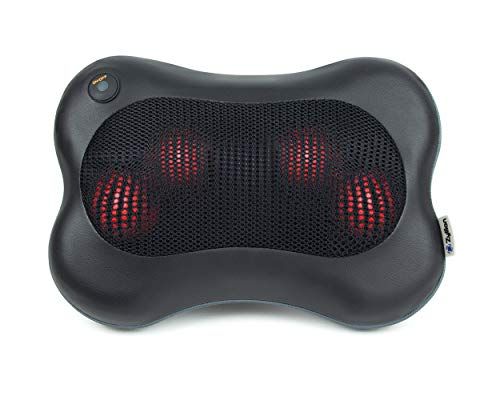The anniversary gift for one year of marriage is typically paper. But for one year of dating? It’s a heated massager pillow. Or, at least, it was for me—an editor perpetually hunched over a computer or my phone—and my boyfriend, a teacher who stands on his feet all day at the mercy of middle schoolers. We frequently came home with the everyday aches and pains of working life—not bad enough to warrant physical therapy, but not exactly comfortable, either.
So, when our anniversary rolled around—meaning we’d spent a year complaining about our various neck and back woes while watching Netflix—I somehow stumbled upon the perfect gift: thoughtful, functional, and affordable AF. For less than $45, this heated back and neck massager pillow not only eased our back problems (no way was he going to be the only one using it, sorry), but it effectively awarded me “Girlfriend of the Year.” Did I mention it has a *nearly* five-star rating on Amazon, and more than 8,800 reviews?

Now, over a year later, we’re still together, and it still works like a charm. So, yeah, you might say it was a worthwhile investment—and I’m not the only one who thinks so. Beret Kirkeby, a licensed massage therapist and owner of Body Mechanics Orthopedic Massage Therapy NYC, says the massager “looks excellent.” (Full disclosure: She hasn’t tried it herself.)
Because the skin has a vast array of sensory organs, such as thermal receptors and pressure receptors, Kirkeby explains, applying both kneading *and* heat can feel amazing. Abby Bales, DPT, a physical therapist and founder of Reform Physical Therapy, agrees, adding that the heat component “helps superficially to increase circulation to the area.”
It’s a trick Kirkeby uses frequently with her patients: “Sometimes, if we are sore and achy, it is nice to give the skin something else to feel,” she explains. “I will use a heating pad or a hot towel in very sensitive areas, and it helps the body relax.”
That, plus the overall massage component—which also helps increase circulation—means more blood is flowing exactly where you want it. “White blood cells go away; new white blood cells come in,” Bales explains. “All that [massaging] is going to just help move things around [in your back and neck], whereas during the day it’s probably pretty stiff.”
Plus, since my boyfriend and I both spend time hunching over our desks—him grading papers, me typing this story—just laying back onto the massager and feeling its “reciprocal motion,” Bales says, is likely to help relieve some discomfort.
Getting into a more relaxed position like this also puts you in a more relaxed mindset, too. In fact, “relaxation techniques of any kind help you manage stress and lower your response to pain,” notes Kirkeby. “Pain is typically generated when your body and mind feel threatened and your stress level is too high, so even if you are not treating the primary problem—for example, a sprained ankle—you can feel less pain by trying to relax.” (Who knew, right?)
This type of massager provides “deep pressure pushback that calms your sympathetic nervous system, which is part of your fight or flight system,” Kirkeby explains. ICYDK, that’s exactly what deep massage therapy does; a formal massage calms your sympathetic system, physically helping you chill out and feel better.



Kirkeby recommends using the massager for only 15 minutes at time (no more) because, at that point, your skin starts to take a lot of the brunt of the heat, and that’s no bueno. “You always want a shirt on between you and this product to protect your skin,” she adds.
That said, you can use it as often as is comfortable for your body. Of course, both Bales and Kirkeby caution against using the massager if you’re feeling sore from a previous use. “If you feel worse after using it, I would not use it again until you got checked out,” Bales adds. “But I don’t see why it couldn’t be part of somebody’s everyday routine, as long as they don’t feel any adverse side effects, like soreness, after using it.”
That’s good news for me, as I plan to keep this massager tool—oh, and my BF—around for a long, long time.
Source: Read Full Article
